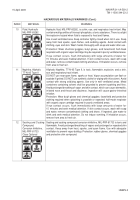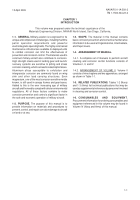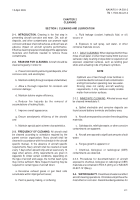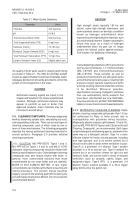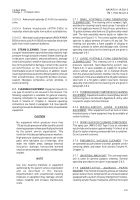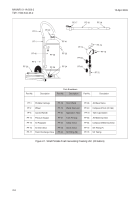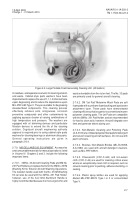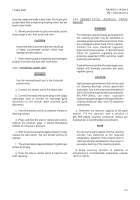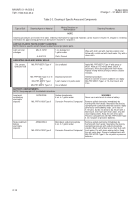TM-1-1500-344-23-2 - Page 29 of 240
2-5
NAVAIR 01-1A-509-2
TM 1-1500-344-23-2
15 April 2009
2-5.10.3. Ammonium hydroxide (O-A-451) to neutralize
urine.
2-5.10.4. Sodium bicarbonate (ASTM D928) to
neutralize electrolyte spills from sulfuric acid batteries.
2-5.10.5. Monobasic sodium phosphate (ANSI/AWWA
B504) or boric acid (A-A-59282) to neutralize electrolyte
spills from nickel-cadmium batteries.
2-6. STEAM CLEANING
. Steam cleaning is defined
as super-heated water vapor delivered at relatively high
pressure through a nozzle or wand. Steam cleaning can
erode paint, craze plastic, debond adhesives, damage
electrical insulation, and drive lubricants out of bearings.
Due to the potential for damage, it shall not be used on
aircraft/missiles at the Organizational/Unit or
Intermediate levels of maintenance. In addition, steam
cleaning shall not be used on the following items removed
from aircraft/missiles: honeycomb bonded structure,
sealant, fiberglass composites, acrylic windows, or
electrical wiring.
2-7. CLEANING EQUIPMENT.
Equipment specific to
one type of aircraft is not covered in this manual. The
following equipment is available for general cleaning.
Ordering information for approved equipment can be
found in Volume IV, Chapter 3. General operating
instructions are found in paragraph 2-8. See specific
operating manuals for detailed instructions on automated
equipment.
CAUTION
No equipment which produces more than
175 psi nozzle pressure shall be used for aircraft
cleaning purposes unless specifically authorized
by the parent service organization. This
restriction includes portable pressure washers.
High-pressure cleaning processes can erode
paint, drive lubricants out of bearings, drive
water into hidden areas, damage electrical
insulation, damage honeycomb bonded
structure and composite surfaces, and damage
sealant.
NOTE
Use only cleaning materials or equipment
authorized by the parent service organization
and as described in this manual.
Experimentation with unauthorized cleaning
materials or equipment may damage aircraft,
reduce reliability and increase maintenance
costs.
2-7.1. SMALL PORTABLE FOAM GENERATING
CLEANING UNIT. The cleaning unit is compact, light,
and ideal for cleaning hard to reach areas. It consists of
a 54 inch applicator wand, 50 feet of hose, and either a
15 gallon stainless steel tank or a 20 gallon carbon steel
tank. The tank assembly moves easily on rubber tire
wheels (see Figure 2-1). The control system allows the
operator to adjust wetness of foam to fit any job. The
cleaning unit provides a foam capable of clinging to
vertical surfaces to soften and dislodge soils. General
operating instructions for the cleaning unit are given in
paragraph 2-8.1.
2-7.2. LARGE PORTABLE FOAM GENERATING
CLEANING UNIT. This cleaning unit is a simplified,
pressure operated, foam-dispensing system (see
Figure 2-2). It uses available air supply for its power
source without using pumps. Air is metered directly
from the pressurized solution chamber into the hose to
create foam. Units are available with a 45 gallon stainless
steel tank or a 50 gallon carbon steel tank. General
operating instructions for the cleaning unit are given in
paragraph 2-8.2.
2-7.3. TURBINE ENGINE COMPRESSOR CLEANING
EQUIPMENT. Equipment used for cleaning Navy aircraft
turbine engines is contained in Appendix A. Army: refer
to specific engine technical manual.
2-7.4. MISCELLANEOUS LARGE CLEANING
EQUIPMENT. Other equipment such as truck or trailer
mounted spray or foam equipment may be available at
certain locations.
2-7.5. SPRAY GUN FOR CLEANING COMPOUNDS.
This spray gun (AMS-G-952 Type I) has an extended
nozzle/tube and requires approximately 14 cfm of air at
50 psi to siphon cleaning compounds from a container.
Do not use with solvents.
2-7.6. PNEUMATIC VACUUM CLEANER. The
air-operated vacuum cleaner is a small, portable unit for
removing debris and water from aircraft (Volume IV,
Chapter 3).
2-7.7. UNIVERSAL WASH UNIT. The universal wash
unit is used for general purpose cleaning. General
operating procedures are given in paragraph 2-8.3.
2-7.8. CABINET-STYLE
AQUEOUS
PARTS
WASHER. This method of cleaning utilizes an industrial
power washer that is comprised of an enclosed cabinet
equipped with a system of spray impingement nozzles,
cleaning solution heater, fluid pump, skimmer for oil and
Change 1 - 31 March 2010
Back to Top

